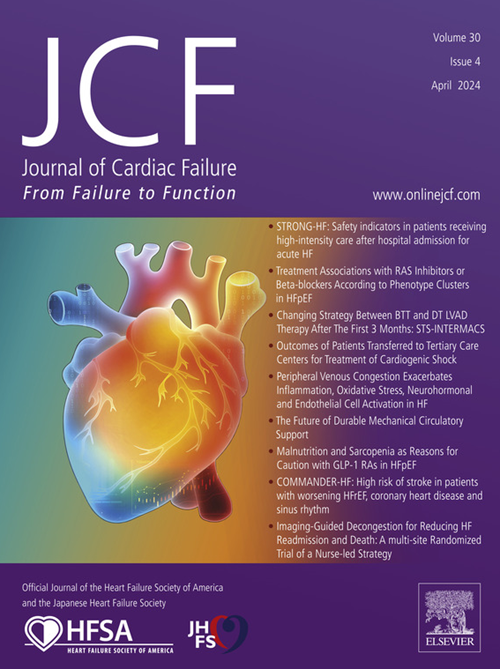Differential Prognostic Impact of Clinical Congestion between Preserved versus Reduced Ejection Fraction in Patients Hospitalized for Acute Decompensated Heart Failure: Findings from the Japanese Kyoto Congestive Heart Failure Registry
IF 8.2
2区 医学
Q1 CARDIAC & CARDIOVASCULAR SYSTEMS
引用次数: 0
Abstract
Background
Most patients hospitalized for heart failure (HF) present with signs of congestion. Prognostic significance of clinical congestion may vary depending on left ventricular ejection fraction (LVEF). This study aims to investigate the prognostic impact of congestion across different LVEF categories.
Methods and Results
Composite congestion scores (CCSs; 0–9) derived from the severity of edema, jugular venous pressure, and orthopnea, were analyzed on admission and at discharge in 3787 patients hospitalized for HF (LVEF ≥ 40%: n = 2347, LVEF < 40%: n = 1440). The median admission CCS was 4 in both LVEF strata (P = .64). Adjusted hazard ratios (HRs; 95% confidence interval [CI]) of the moderate (CCS 4–6) and severe congestion [7–9] groups relative to the mild congestion [0–3] group on admission for a composite of all-cause death or HF rehospitalization were 1.20 (1.04–1.39, P = .01) and 1.54 (1.27–1.86, P < .001) in the LVEF ≥ 40% stratum, and 1.20 (1.01–1.44, P = .04) and 0.82 (0.61–1.07, P = .14) in the LVEF < 40% stratum, respectively (Pinteraction< .001). A total of 16% of the patients with LVEF ≥40% and 14% with LVEF <40% had residual congestion (CCS ≥ 1) at discharge, which was associated with a respective adjusted HR of 1.40 (1.18–1.65, P < .001) and 1.25 (0.98–1.58, P = .07) for postdischarge death or HF rehospitalization (Pinteraction = 0.63).
Conclusion
The severity of clinical congestion on admission was associated with adverse clinical outcomes in patients with LVEF ≥ 40%, but not in those with LVEF < 40%. These findings warrant further studies to better understand the detailed profile of congestion across the LVEF spectrum.
在因急性失代偿性心力衰竭住院的患者中,射血分数保留与减少对临床充血的预后影响存在差异:来自日本 KCHF 登记处的研究结果。
背景:大多数因心力衰竭(HF)住院的患者都会出现充血症状。临床充血的预后意义可能因左心室射血分数(LVEF)而异。本研究旨在探讨充血对不同 LVEF 类别预后的影响:对 3787 名因高血压住院的患者(LVEF≥40%:n=2347,LVEF 交互作用=0.63)在入院时和出院时的水肿严重程度、颈静脉压和呼吸暂停得出的综合充血评分(CCS)(0-9)进行了分析:结论:LVEF≥40%的患者入院时临床充血的严重程度与不良临床结果有关,但LVEF≥40%的患者入院时临床充血的严重程度与不良临床结果无关。
本文章由计算机程序翻译,如有差异,请以英文原文为准。
求助全文
约1分钟内获得全文
求助全文
来源期刊

Journal of Cardiac Failure
医学-心血管系统
CiteScore
7.80
自引率
8.30%
发文量
653
审稿时长
21 days
期刊介绍:
Journal of Cardiac Failure publishes original, peer-reviewed communications of scientific excellence and review articles on clinical research, basic human studies, animal studies, and bench research with potential clinical applications to heart failure - pathogenesis, etiology, epidemiology, pathophysiological mechanisms, assessment, prevention, and treatment.
 求助内容:
求助内容: 应助结果提醒方式:
应助结果提醒方式:


